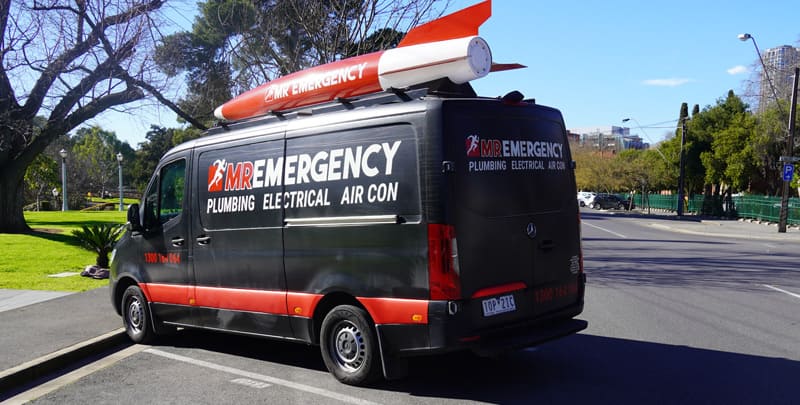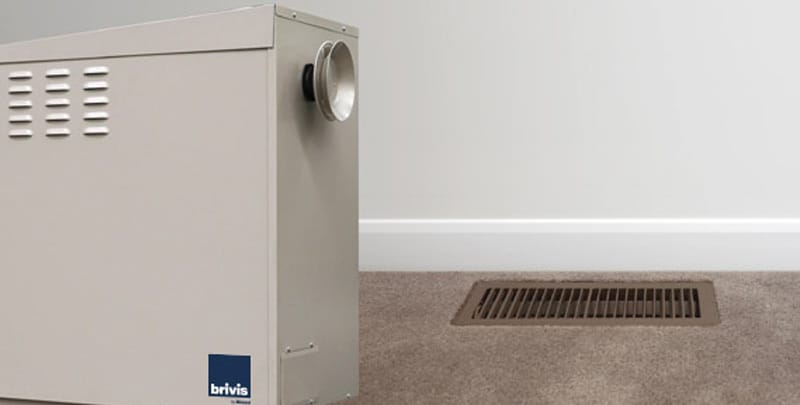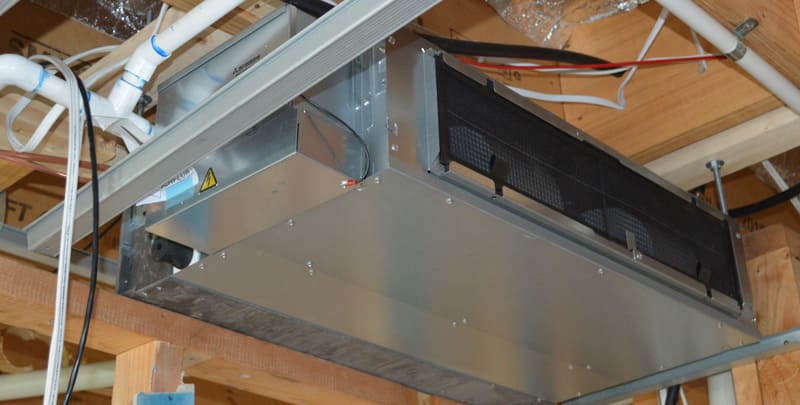
Ducted Heating – Highly Efficient and Versatile
Ducted heating, in its essence, is a highly efficient and versatile method of home heating. It involves using a central heating unit, which produces warm air.
This air is then ducted gas heater and circulated throughout the house via ducts, vents, and registers, ensuring even heat distribution.
The concept of a ducted gas heating system or reverse cycle ducted heating has a rich historical background, dating back to ancient civilisations that devised ingenious ways to channel heat within their dwellings.
Ducted heating refers to a heating system where warm air is generated by a well heater or central heating unit and distributed throughout a building via a network of ducts.
This heating and cooling method allows for efficient heating of multiple rooms or the entire house, providing comfort during colder months.
A Brief History of Ducted Heating
Ancient Rome built hypocausts – an early form of underfloor heating, tracing the roots of ducted heating back to that time.
Over the centuries, various heating methods evolved, leading to the development of modern ducted heating systems in the 20th century. As technology advanced, these systems became more energy-efficient and environmentally friendly.
Importance of Home Heating
Home heating is not just a matter of comfort; it’s a crucial aspect of creating a healthy living environment.
Proper heating ensures that the indoor temperature is conducive to human well-being, preventing illnesses related to cold weather exposure. It protects your home from mould and dampness, which can arise in cold, humid conditions.
How Ducted Heating Works
Ducted heating operates on a straightforward principle. A furnace or heating unit, often powered by gas or electricity, genre.
This heat is then transferred to the air and propelled through a network of ducts. Strategically placed ducts throughout the house connect to vents and registers in each room.
The thermostat acts as the control centre, allowing homeowners to set the desired temperature.
When the system is activated, warm air is pushed through the ductwork and into rooms, providing consistent and comfortable heating.
Components of a Ducted System
The different components of a ducted heating system include:
- Furnace or heater unit: The heart of any ducted heating system is the furnace or heating unit. Gas furnaces burn natural gas to produce heat, while electric furnaces use heat elements. Both methods are highly efficient, and conditions can provide substantial warmth even in extreme cold.
- Ductwork: This comprises a network of pipes or channels that carry heated air from the furnace to various rooms in the house. Properly insulated ducts ensure minimal heat loss during transportation, maximising energy efficiency.
- Vents and registers: Vents and registers are the visible components of the heating system installed in walls, floors, or ceilings. They distribute warm and cold air into the rooms and can be adjusted to control the airflow and temperature in each area.
- Thermostat: The thermostat serves as the brain of the heating system. Modern thermostats are programmable, allowing homeowners to set specific temperatures for different times of the day. Smart thermostats enable remote control via smartphones, enhancing convenience and energy savings.
- Heating process and heat distribution: When the heating system for the entire home is activated, the gas heater in the furnace ignites, producing heat. The blower fan pushes air through the stove, heating it before distributing it through the ducts. As the warm air reaches rooms, it rises, displacing cooler air to create a continuous cycle of comfortable, even heating.

Types of Ducted Heating Systems
Ducted heating systems have several variations, each with unique features and advantages.
- Central ducted heating: Central ducted heating is the most common type, featuring a central heating unit, just one system that distributes warm air to different rooms or whole homes. This system is efficient for medium to large homes, providing consistent heating throughout the house.
- Ducted reverse cycle air conditioning: Ducted reverse cycle air conditioning systems provide both heating and cooling capabilities. They use a heat pump to transfer warm or cool air into the living spaces. This versatility makes them suitable for year-round use, maintaining a comfortable indoor environment regardless of the weather outside.
- Gas ducted heating: Gas-ducted heating systems use natural gas as a fuel and electricity source. They are energy-efficient and cost-effective, making them a popular choice among homeowners. Gas ducted heating units can quickly warm up spaces and maintain the desired temperature efficiently.
- Electric ducted heating: Electric ducted heating systems rely on heating elements to warm the air quickly. While clean and easy to install, they might have higher operational costs than gas systems. However, technological advancements have led to more energy-efficient electric ducted heating options.
Benefits and Drawbacks of Each Type
Each type of ducted heating system has its advantages and drawbacks. Central ducted heating provides even warmth throughout the house, but installation costs can be significant. Ducted reverse cycle air conditioning offers both heating and cooling.
Still, it might be less energy-efficient than dedicated heating and cooling systems. Ducted heating is cost-effective and quick but requires a natural gas supply.
Electric ducted heating is clean but might have higher operating costs. Choosing the right type depends on individual preferences, budget, and specific heating needs.
Advantages of Ducted Heating
There are many benefits to having ducted heating installed in your home. They include:
- Energy efficiency and cost savings: Ducted heating systems, especially those powered by gas, are energy-efficient, providing substantial cost savings in energy bills in the long run. Properly insulated ductwork ensures minimal heat loss during distribution, maximising efficiency.
- Even temperature distribution: One of the significant advantages of a gas-ducted heating system is its ability to provide even temperature distribution. Unlike other heating methods that create hot and cold spots, ducted heating maintains a consistent temperature throughout the house, ensuring comfort in every room.
- Improved indoor air quality: Ducted heating systems often feature air filters that trap dust, pollen and other parts that improve circulation. This filtration process improves indoor air quality, benefiting individuals with allergies or respiratory issues.
- Convenience and control: Modern ducted heating systems come with advanced thermostats and control options. Homeowners can program heating schedules, set specific temperatures for different zones, and even control the system remotely using smartphones or tablets. This level of convenience enhances the overall user experience.
- Zoning options: Zoning allows homeowners to divide the houses into different heating zones. You can control each zone independently, enabling personalised enhanced comfort areas. This feature improves comfort and contributes to energy savings by heating only the occupied spaces.
Installation and Maintenance
How do you get started from scratch? Here are some installation and maintenance tips.
Planning and Design Considerations
Careful planning and design are essential Before installing a ducted heating system. Consider factors such as the size of the house, insulation, and the number of rooms.
A professional HVAC technician can assess these factors and design a customised system that meets the specific heating requirements of your various rooms.
Installation Process
The installation involves several steps, including positioning the central heating unit, installing ductwork, placing vents and registers in just one system, and connecting the thermostat. Proper installation is crucial for the system’s efficiency and longevity.
Recommend hiring experienced technicians to ensure a seamless installation process.
Routine Maintenance Tips
Regular maintenance is critical to operating a ducted heating system at peak performance. Homeowners can perform routine tasks, such as replacing air filters, cleaning vents, and checking thermostat settings.
Additionally, scheduling annual professional inspections and maintenance services is essential to address potential issues and ensure the system’s longevity.
Troubleshooting Common Issues
Even well-maintained systems can encounter occasional problems. Common issues include uneven heating, strange noises, or thermostat malfunctions.
Troubleshooting these problems may require professional assistance, as they can indicate underlying issues that need expert diagnosis and repair.
Comparing Ducted Heating to Other Options
Ducted heating is just one of several heating options available to owners. Understanding how ducted gas heaters compare to other methods can help you make an informed decision.
- Ducted heating vs split system air conditioning: Ducted heating offers a range of whole-house heating, while split-system air conditioning units are primarily designed for individual rooms. Ducted heating provides even warmth throughout the house, but several split systems offer localised control. The choice depends on the size of your home and your heating preferences.
- Ducted heating vs radiant heating: Radiant heating systems, underfloor or wall-mounted gas heaters below, provide heat directly to objects and people in a room. On the other hand, ducted heating warms the air and circulates it. Rant heating can create a cosy, warm sensation but may result in uneven heating. Ducted heating provides consistent warmth in all rooms.
- Ducted heating vs hydronic heating: Hydronic heating uses water or steam to heat a space: it’s ducted and quiet. While ducted and hydronic heating can provide even warmth, hydronic systems are often more expensive to install and are best suited for new construction or extensive renovations.

Your Ducted Heating System’s Sustainability
The energy source for your ducted heating system can significantly impact its environmental footprint.
Gas systems emit greenhouse gases, while electric systems depend on the energy grid. Exploring renewable energy sources, such as solar or heat pumps, can make your heating system more environmentally friendly.
Ducted Heating and Carbon Footprint
Reducing the carbon footprint is a growing concern. Gas ducted heating systems emit carbon dioxide (CO²) during combustion, contributing to global warming.
Choosing a high-efficiency gas ducted gas heating system or exploring alternative heating sources can help minimise this impact.
Eco-Friendly Heating Alternatives
For those committed to environmental sustainability, there are eco-friendly heating alternatives to consider.
Solar heating systems harness the sun’s power, while heat pumps use ambient heat from the air or ground. These options offer lower carbon emissions and reduced reliance on fossil fuels.
Government Incentives and Rebates
State governments and local authorities offer incentives and rebates to encourage the adoption of energy-efficient and environmentally friendly heating systems.
Researching available incentives can help homeowners make eco-conscious choices while saving on installation costs.
Cost and Budgeting
A ducted heating and cooling system is a genuine investment in your own property but setting it up can be costly. Let’s take a look at the upfront costs of a ducted system:
- Initial investment: The cost of installing a ducted heating system varies based on factors such as the size of your home, the type of system chosen, and the complexity of the installation. Budgeting for the design and any necessary modifications to your home’s infrastructure is essential.
- Operational costs: Operational costs include the cost of energy and operating electric ones lower operating costs compared to electric systems. Proper insulation and regular maintenance can also help optimise energy efficiency and reduce ongoing expenses and running costs.
- Factors affecting the cost: Several factors can influence the overall cost of a ducted heating system, including the system type, insulation quality, ductwork complexity, and the need for additional components or air purification systems. Multiple quotes from reputable HVAC contractors can help you get a clearer picture of the costs involved.
- Financing options and incentives: Financing options, such as low-interest loans or financing plans offered by HVAC companies, can make the initial investment more manageable. Additionally, exploring available rebates, tax credits, or energy efficiency incentives can provide financial relief and encourage eco-friendly choices.
Ducted Heating Maintenance and Troubleshooting
To ensure the longevity and efficiency of the heating and cooling system throughout the process, follow a regular maintenance checklist. It may include tasks such as:
- Changing air filters regularly
- Cleaning vents and registers
- Lubricating moving parts
- Inspecting ductwork for leaks or damage
- Calibrating and testing the thermostat
Common Issues and Their Solutions
Despite regular maintenance, ducted heating systems can encounter common issues like uneven heating, strange noises, or thermostat malfunctions. Troubleshooting these problems may involve:
- Checking for blocked vents or registers
- Adjusting thermostat settings
- Inspecting ductwork for obstructions or damage
- Calling a professional technician for complex issues
- When to call a professional
While homeowners can perform some maintenance tasks, there are instances when it’s essential to call a professional HVAC technician.
These include significant repairs, complex troubleshooting, system upgrades, or safety concerns. Professional maintenance ensures the system’s reliability and safety.
Ducted Heating: Is it Right for Your Home?
Ducted heating is a versatile and efficient home heating and cooling solution that offers even temperature distribution, top energy ratings, improved indoor air quality, and advanced control options.
Understanding how ducted heating works, its advantages, types, and choices can help homeowners make informed choices about their heating systems.
Is ducted heating right for your home? The answer depends on your heating needs, budget, and environmental priorities. You can determine whether ducted heating aligns with your goals and preferences by considering installation costs, energy sources, and maintenance requirements.
In a world increasingly focused on energy efficiency and sustainability, ducted heating remains viable and practical for keeping your home warm and comfortable. Whether you opt for a gas, electric, or hybrid system, ducted heating can provide the warmth and convenience you need while minimising your environmental impact.
For more information contact the ducted heating experts at Mr Emergency.
Please note: This information is provided for advice purposes only. Regulations differ from state to state, so please consult your local authorities or an industry professional before proceeding with any work. See our Terms & Conditions here.


